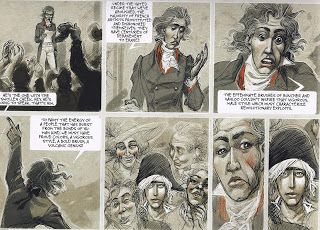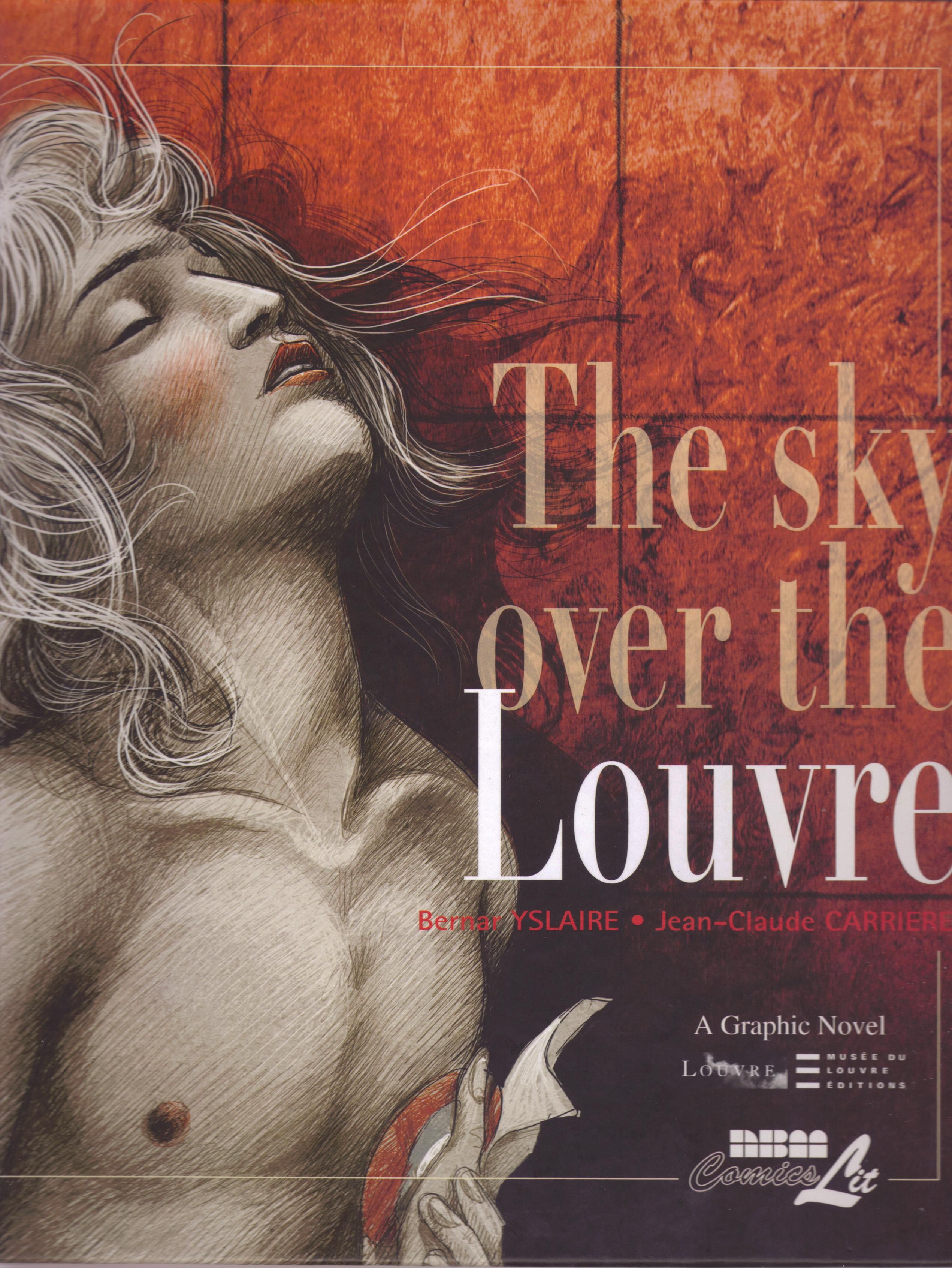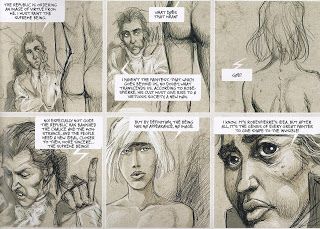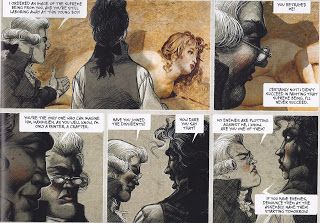Here's an odd beast!
The Sky Over the Louvre is the latest in a series of graphic novels co-pulblished with the museum itself. That's a bit strange, yet awesome at the same time. Here in the colonies, it's published by NBM, which sells it for $19.99. The book is the brainchild of Bernar Yslaire (Bernard Hislaire), who's been drawing comics since the mid-1970s. He had the idea, laid the book out, drew it, and colored it. He wrote it in conjunction with Jean-Claude Carrière, who's been writing screenplays since the 1960s (including the one for Chinese Box, which is a pretty darned good movie).
The Sky Over the Louvre tells a story of the French Revolution, just when the building had been turned into a museum from a palace (yes, the Louvre was once a palace, for those who didn't know that).
It's the time of the Terror, and things are not going well in Paris and France in general. The book is mainly concerned with Jacques-Louis David, who painted "The Death of Marat," one of the most famous paintings of the period (the book begins with David and Robespierre, to whom the artist hitched his star during this time, discussing the painting and what David was trying to do achieve), and his attempts to continue with the propaganda of the regime even as Robespierre, the architect of the Terror, made increasingly difficult demands on the painter's abilities. Robespierre wanted David to create a painting of a "supreme being" which would replace God in the people's hearts, because even Robespierre recognized the need for religion in a nation. Meanwhile, a young man who claims to be from "Khazaria" (which didn't exist in 1793 and hadn't existed for over 800 years) arrives in Paris and bewitches David, who eventually wants to use him as a model. The young man, Jules Stern, seems to be some kind of harbinger, claiming that the Revolution will eventually destroy Robespierre, which of course it did. It's never clear if Stern is more than human, but there's at least an implication that he is.
David is also tasked to paint Joseph Bara, a 13-year-old who managed to get into the army and was killed by Breton royalists. Robespierre and the Convention wanted to turn him into a martyr of the Revolution, so they turned to David. As David grew increasingly frustrated with his attempts to paint the "supreme being," he found in Jules a perfect model for Bara. Then Jules is guillotined, but David finds his body and uses it to complete his painting. It's a particularly horrific scene as he and his assistants stitch Jules's corpse together so that David can finish the work. Meanwhile, of course, his depiction of the "supreme being" helps bring about Robespierre's downfall, a fate that David narrowly escaped. His painting of Joseph Bara, of course, lives on.
What's fascinating about the comic is the way Yslaire shows how David and even the French people desire something greater than themselves to believe in.
They turn a palace into a "people's museum," Robespierre tries to establish a "religion of logic," David ignores the creation of a supreme being because he has found Jules to represent that supreme being for him, and even at the end, David's assistants comment that he found a new supreme being - Napoleon (David, of course, painted this famous scene of Napoleon crossing the Alps). David's desperate desire to find something to believe in is mirrored by the French, as they tumultuously veer from one despot to another, slaughtering the old in fickle fashion to make room for the new. Jules Stern, the symbol of innocence in the comic, is killed and then resurrected in grotesque mockery of Jesus, but David can't see how monstrous this action is because all that matters to him is the beauty of the sublime, and if he has to create a Frankenstein's monster out of his model, so be it. Yslaire, wisely, doesn't comment on David's horrific actions, mainly because it needs no overt condemnation. By focusing on what David does when in the throes of the Terror, Yslaire is able to move from the general mood of the populace during this time to the specific horrors they perpetrated. This is a comic about the limits of art and what people go through to create art, both in painting and, as the revolutionaries attempted, in government. David and Robespierre never let the messiness of humanity get in their way of creating something beautiful, and they are far more monstrous for it.
Yslaire's art is quite excellent, as he incorporates several actual paintings into the narrative (a list is found at the end of the book) to show how the revolutionaries tried to change the art of the ancien régime. The paintings are blended nicely into the book, and Yslaire is very good at showing how the ideal world of the paintings contrasts with the base world of the Terror. He does this early on with the portrait of Madame Charles-Louis Trudaine, whose painting is far more attractive than the woman herself.
There's nothing new in this, of course, but it shows how David distorts reality, which he does in far more sinister fashion with Jules Stern (and, of course, later with Napoleon, who crossed the Alps on a mule, not the great horse that David paints). Yslaire does a very good job showing that the people of the Revolution are, naturally, just people, and artists like David turn them into immortal beings. The coloring of the book is done well, too, as Yslaire keeps things relatively dull, allowing the paintings to stand out. He adds nice splashes of color - mostly red - throughout the book, symbolizing both the tricolor and the blood of the Terror. It's a beautiful book, bringing Yslaire's ideas to fruition quite nicely.
The Sky Over the Louvre is only 66 pages long, which for 20 bucks might be a bit much for you. It's a large hardcover, though, and it's quite dense, so there's that. I liked it far more than the first "Louvre edition" that I got a few years ago (I missed the second one), for what that's worth. It's an impressive book about a horrific time in history, and Yslaire has done a nice job making the actions of the mob a bit more comprehensible. Whenever something terrible occurs, we struggle to understand it. The Sky Over the Louvre doesn't explain it all, but it does show one reason why the Revolution went so horribly wrong. Plus, it's a creepy psychological drama, which is always cool to read.




